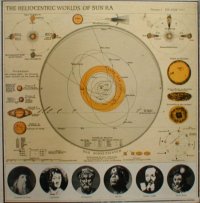| The Heliocentric Worlds of Sun Ra, Volume Two | ||||
|---|---|---|---|---|
 | ||||
| Studio album by Sun Ra and his Solar Arkestra | ||||
| Released | 1966 | |||
| Recorded | November 16, 1965 | |||
| Genre | Free jazz | |||
| Length | 36:45 | |||
| Label | ESP-Disk | |||
| Sun Ra and his Solar Arkestra chronology | ||||
| ||||
| Review scores | |
|---|---|
| Source | Rating |
| AllMusic | |
| The Penguin Guide to Jazz Recordings | |
| The Rolling Stone Jazz Record Guide | |
The Heliocentric Worlds of Sun Ra, Volume Two is a 1965 recording by the jazz musician Sun Ra and his Solar Arkestra. Where Volume One of the Heliocentric Worlds series had predominantly featured short abstract pieces, Volume Two features longer pieces [4] performed by a smaller group, [5] making it closer in spirit to the contemporaneous The Magic City , released on Ra's own Saturn label. The record has been widely bootlegged, some versions of which were retitled The Sun Myth. [6]
Contents
The album was re-released on CD by ZYX-Music (ESP 1017–2) in the 1990s.